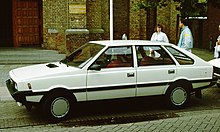Fabryka Samochodów Osobowych
| Fabryka Samochodów Osobowych
|
|
|---|---|
| legal form | Corporation |
| founding | August 1, 1948 |
| Seat |
Warsaw , Poland |
| management | Janusz Woźniak |
| Number of employees | 1,380 |
| Branch | Automotive industry |
| Website | www.fso-sa.com.pl |
Fabryka Samochodów Osobowych ( FSO for short , German factory for passenger cars ) is a former Polish automobile manufacturer and today's capital investment company based in Warsaw .
history

The beginnings with Warszawa and Syrena
In order to get automobile production going in Poland after the Second World War, a factory for passenger cars , in Polish Fabryka Samochodów Osobowych (FSO), was founded in Warsaw in August 1948 . In July 1948, a contract was signed with the Italian automobile manufacturer of the same name, with whom good relations had already existed before the war, for the license production of a Fiat brand passenger car, which was still in development at the time. The factory required for this was built by the Polish government in May 1949 in the northern Warsaw district of Żerań in the district of Białołęka on the east bank of the Vistula . Due to the difficult political situation in the immediate post-war period, however, the planned cooperation did not take place. Rather, at the insistence of the Soviet government, under whose political control the People's Republic of Poland , which was proclaimed in 1944 , the GAZ-M20 Pobeda passenger car from the Soviet Union was to be manufactured under license for the Polish domestic market. From November 1951, the production of the vehicle, later marketed as Warszawa , took place. Initially manufactured as a mere assembly of parts from the Soviet plant in Gorki , from September 1953 the gasoline engines were finally manufactured in Poland and gradually the production of the other parts was also taken over until the end of 1956.
In 1953 a group of developers at FSO worked on the development of a more compact passenger car. This was presented in 1957 under the brand name Syrena and was a vehicle developed entirely by FSO in-house. Exceptions were some models that were equipped with imported Wartburg 1000 engines from the Eisenach automobile plant . The production of the vehicle was handed over to Fabryka Samochodów Małolitrażowych (FSM) in Tychy in 1972 .
The era of the Polski Fiat and Polonez


In December 1965, the Polish government signed license agreements with the Italian car manufacturer Fiat to manufacture selected models in Poland under the Polski Fiat name . In particular, the Fiat 125, which was under development at the time, was to be built by FSO to replace the outdated Warszawa . The result was the Polski Fiat 125p , a simplified Fiat 125 body with the mechanics of the Fiat 1300 and Fiat 1500 . The vehicles were exported as the Fiat 125p and from 1983, after the license agreement expired, as the FSO 1300 or FSO 1500 . There were also station wagon and pick-up versions. The Warszawa was built in parallel until 1973.
From 1973 to the beginning of the 1980s, other Fiat models ( Fiat 127 , Fiat 128 , Fiat 131 , Fiat 132 ) were also assembled at FSO , as well as the Zastava 101 , which was built in what was then Yugoslavia , as a hatchback version of the Fiat 128 .
In May 1978 the Polonez was presented as a new model by FSO. This was a four-door hatchback with tailgate, the mechanical components of the FSO in 1500 took advantage. The passenger car was based on a study of the Fiat 125 designed to optimize pedestrian protection . The Polonez was exported to many countries under its own brand name FSO. It was originally intended to replace all variants of the FSO 1500 model. Its production was continued until 1991, with both models being revised several times during this time.
The Daewoo era

After the system change in 1989, the Polish government wanted to privatize FSO and looked for a suitable partner among the international automobile manufacturers. Despite many attempts and negotiations, no interested party was found for many years. The first constructive cooperation began in 1994 with the signing of a contract with General Motors (GM) for the assembly of the Opel Astra in Żerań. Nevertheless, the following year, FSO was practically sold to the South Korean car manufacturer Daewoo , which at the time was still independent and competed with GM. The company was renamed Daewoo-FSO .
At the beginning, Daewoo-FSO assembled the Daewoo Nexia and Daewoo Espero models in Żerań . In 1997 the assembly and finally complete production of the Daewoo Lanos began . The Daewoo Matiz followed in 1999 . Other Daewoo models from this period were also assembled in Poland for the European market. The manufacture of the Polonez was retained; the models were modernized and new body styles introduced. Due to the falling demand, however, the Polonez production was completely stopped in 2002 .
In the meantime, GM decided to set up its own production facility in Gliwice in the south of Poland, where the Opel Astra has been manufactured since 1998 . Daewoo-FSO took over the assembly of the Opel Vectra for the Polish market.
Last years as an automobile manufacturer
In 2000, the South Korean parent company Daewoo filed for bankruptcy, which led to an acute deterioration in the situation in Żerań. Daewoo itself was taken over by GM and its Asian partners, but the overseas activities were not part of the negotiations.
In lengthy negotiations, the Polish government succeeded in allowing FSO to continue to manufacture and sell the Daewoo models Lanos and Matiz under its own brand FSO until 2007. However, FSO lacked the funds for further necessary model maintenance measures, which caused the sales figures to fall sharply, especially on the domestic market in Poland. On the other hand, FSO was successful with both vehicles on the Ukrainian market, where they, assembled by AwtoSAS , achieved great popularity.
In 2004, FSO officially reverted to the original company name. The Polish government was looking again for a strategic partner for FSO, but no major automobile manufacturer showed any interest in the company and its factory facilities. Finally, FSO started negotiations with the British MG Rover Group , in the course of which the British manufacturer itself increasingly got into difficulties and was looking for cooperation partners in China . The MG Rover Group filed for bankruptcy in 2005, which for FSO dashed all hopes associated with the British. In the same year, FSO entered into a collaboration with the Ukrainian automobile manufacturer UkrAWTO , as a result of which the Ukrainians became majority owners of FSO.
In September 2007, GM announced that it would take over 40 percent of FSO for US $ 255 million and transfer it to a joint venture called GM FSO. Together with UkrAWTO , the Chevrolet Aveo was manufactured in Warsaw from November 2007 . In February 2011, over 100,000 Aveo vehicles rolled off the assembly line at FSO. In the same month the license expired and there was no renewal. Due to a lack of orders, the workforce was laid off until October 2011 and a large part of the machines, systems and tools were auctioned.
Current situation
At peak times, FSO employed over 25,000 people in its facility. After discontinuing its activities as an automobile manufacturer, FSO is now concentrating on its equity investments. These include several joint ventures with automotive suppliers and component manufacturers as well as investments in service companies in the automotive sector. Most of the company's own properties are rented to other automobile manufacturers. FSO currently employs 1,380 people.
Timeline
| Illustrated timeline of the vehicles from Fabryka Samochodów Osobowych (FSO) or Daewoo-FSO or GM-FSO since 1951 | ||||||||||||||||||||||||||||||||||||||||||||||||||||||||||||||
|---|---|---|---|---|---|---|---|---|---|---|---|---|---|---|---|---|---|---|---|---|---|---|---|---|---|---|---|---|---|---|---|---|---|---|---|---|---|---|---|---|---|---|---|---|---|---|---|---|---|---|---|---|---|---|---|---|---|---|---|---|---|---|
| Brands | FSO (state-owned company) | Daewoo FSO | FSO | |||||||||||||||||||||||||||||||||||||||||||||||||||||||||||
| JV with Fiat | JV with GM | JV GM-FSO | ||||||||||||||||||||||||||||||||||||||||||||||||||||||||||||
| 1950s | 1960s | 1970s | 1980s | 1990s | 2000s | 2010s | ||||||||||||||||||||||||||||||||||||||||||||||||||||||||
| 1 | 2 | 3 | 4th | 5 | 6th | 7th | 8th | 9 | 0 | 1 | 2 | 3 | 4th | 5 | 6th | 7th | 8th | 9 | 0 | 1 | 2 | 3 | 4th | 5 | 6th | 7th | 8th | 9 | 0 | 1 | 2 | 3 | 4th | 5 | 6th | 7th | 8th | 9 | 0 | 1 | 2 | 3 | 4th | 5 | 6th | 7th | 8th | 9 | 0 | 1 | 2 | 3 | 4th | 5 | 6th | 7th | 8th | 9 | 0 | 1 | ||
|
|
 FSO Syrena 100/101/102/103/104/105 1957 to 1972 |
then continued production by FSM until 1983 | ||||||||||||||||||||||||||||||||||||||||||||||||||||||||||||
 FSO Warszawa M20 / 200/201/201 1951 to 1964 |
 FSO Warszawa 203/204/223/224 1964 to 1973 |
|||||||||||||||||||||||||||||||||||||||||||||||||||||||||||||
|
|
 FSO Polonez 1978 to 1991 |
 FSO Polonez Caro 1991 to 1996 |
 Daewoo-FSO Polonez Atu / Plus 1996 to 2002 |
|||||||||||||||||||||||||||||||||||||||||||||||||||||||||||
|
|
 Polski Fiat 125p 1967 to 1982 |
 FSO 125p / 1300/1500 1983 to 1991 |
||||||||||||||||||||||||||||||||||||||||||||||||||||||||||||
|
later |
 Daewoo Lanos 1997 to 2004 |
 FSO Lanos 2004 to 2007 |
||||||||||||||||||||||||||||||||||||||||||||||||||||||||||||
 Daewoo Matiz 1999 to 2004 |
 FSO Matiz 2004 to 2007 |
|||||||||||||||||||||||||||||||||||||||||||||||||||||||||||||
 Chevrolet Aveo 2007 to 2011 |
||||||||||||||||||||||||||||||||||||||||||||||||||||||||||||||
| In addition, FSO assembled vehicles from Fiat (127, 128, 131, 132 and Ritmo) and Zastava (1100) in the 1970s, as well as vehicles from Daewoo (Tico, Espero, Nubria, Tacuma and Leganza) and Opel (Astra and Vectra) in the 1990s ). | ||||||||||||||||||||||||||||||||||||||||||||||||||||||||||||||
literature
- Bernard Vermeylen: FSO: The foundation of the Polish auto industry . In: Cars from the Eastern Bloc , Verlag Delius Klasing, Bielefeld 2010, ISBN 978-3-7688-3149-9 ; Pp. 67-88
- Passenger cars from Zeran. In: Motor vehicle technology , issue 1/1952, p. 13 and 3/1952, p. 90
- The automotive industry in the People's Republic of Poland. In: Motor vehicle technology , issue 7/1954, pp. 193–195
Web links
Individual evidence
- ↑ Bernard Vermeylen: FSO: The foundation of the Polish auto industry . In: Cars from the Eastern Bloc , Verlag Delius Klasing, Bielefeld 2010, ISBN 978-3-7688-3149-9 ; Pp. 67-88
- ↑ Reuters: GM Daewoo to buy 40 pct of Poland FSO for $ 255 mln , September 10, 2007
- ↑ Press release from General Motors Germany on the start of Chevrolet production in Warsaw
- ^ History. FSO Polonez Club Germany, accessed December 19, 2016 .

